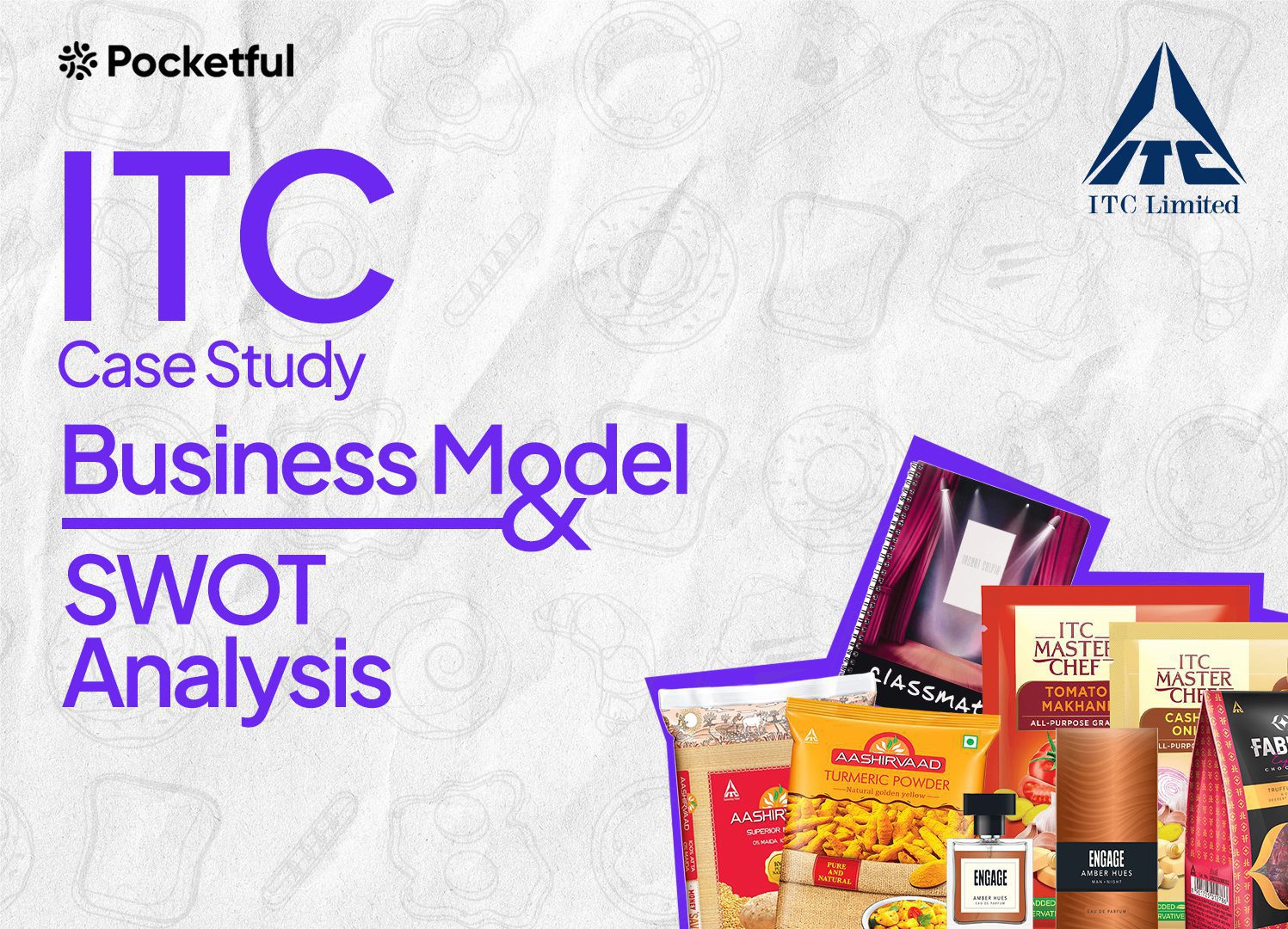| Type | Description | Contributor | Date |
|---|---|---|---|
| Post created | Pocketful Team | Mar-20-24 | |
| Add new links | Nisha | Apr-11-25 |

- Blog
- itc case study business model financials and swot analysis
ITC Case Study: Business Model, Financials, and SWOT Analysis

Cigarette smokers know brands like Classic and Gold Flake. People who cook food are aware of brands like Ashirvaad Atta, and students use brands like Classmate. But did you know that all these brands, and many more, belong to ITC?
Almost every person in the nation has used an ITC product at some point in their lives. In today’s blog we will take a closer look at the largest FMCG brand in India, ITC.
Overview of ITC
First established in 1910, ITC was initially known as the Imperial Tobacco Company of India Limited. In 1970, the company renamed itself as Indian Tobacco Company, and it did so again in 1974 when it became I.T.C. Limited.
The company now operates in a much wider range of sectors, such as packaging, lodging, and fast-moving consumer goods. The company’s head office is located in Kolkata.
In the previous ten years, their organization has created a diverse portfolio of over 25 premium Indian brands. Their “Nation First” philosophy has helped establish a lucrative and competitive global environment.

Did You Know?
ITC is the only company in the world of comparable dimensions to be carbon, water, and solid waste recycling positive.
Awards and Recognitions
- Pulp and Paper International Awards by Fastmarkets RISI.
- First Prize in “Best in Industry for CSR Activities” at the National Water Awards 2022.
- The SABRE Award for achievement in Reputation Management in 2021.
- “Best Governed Company” at ISCI National Awards for Excellence in Corporate Governance 2020.
- “The Corporate Hotelier of the World Award 2019” from Hotels USA.
Did You Know?
Renewable energy makes up about 43% of the total energy used in ITC.
Market Details of ITC
| Current Market Price | INR 413 |
| Book Value | INR 55.4 |
| 52 Week High | INR 499.70 |
| 52 Week Low | INR 372 |
| Face Value of Share | INR 1 |
| TTM PE | 25.2 |
| Market Capitalization | 517,117 Cr. |
Read Also: BAT Stake Sale in ITC: Overview, Reasons, and Impact on Shareholders Explained
Business Model of ITC
The major pillars of ITC business model focus on multiple revenue streams, diversification, and customer satisfaction.
1. Diversification – Their company operates in several industries, such as FMCG, packaging, lodging, etc. They provide affordable products to a diverse range of customers in each business.
2. Revenue Streams – Although the sale of cigarettes is their main source of income, they also make money from hotels, FMCG, and paperboard segments.
3. Presence – ITC is recognizable nationwide due to its vast corporate presence and reputation, which they have developed over time.
4. Distribution Network – Reaching every region of the nation is possible because of ITC’s extensive and dispersed distribution network.
Segments of ITC
The operations of ITC can be classified into 4 major segments.
1. FMCG – ITC has a strong representation in the sector of Fast Moving Consumer Goods (FMCG). They sell a wide range of goods, including branded packaged food products, cigarettes, stationery products, and personal care items.
2. Agri Business – The segment of the business sells a variety of goods like unmanufactured tobacco, wheat, rice, and spices. The segment provides brands like Kitchens of India, Aashirvaad, Sunfeast, and Bingo. sdaA
3. Hotels – They own various hotels around the nation that provide first-rate hospitality services.
4. Paperboards, Paper and Packaging – ITC is one of the biggest paper manufacturers in India, and its eco-friendly product line is well-known.
Financial Highlights of ITC
Balance Sheet
| Particulars | 31st March 2023 | 31st March 2022 | 31st March 2021 |
|---|---|---|---|
| Total Non-Current Assets | 47058.3 | 44150.49 | 39765.12 |
| Total Current Assets | 35203.44 | 30942.01 | 31815.24 |
| Total Assets | 82261.74 | 75092.5 | 71580.36 |
| Total Equity | 67593.8 | 61399.57 | 59004.62 |
| Total Non-Current Liabilities | 2252.32 | 2214.84 | 2401.79 |
| Total Current Liabilities | 12415.62 | 11478.09 | 10173.95 |
The graph indicates a substantial increase in major line items. Thus, indicating a slow but consistent growth trajectory without raising non-current debt.
Income Statement
| Particulars | 31st March 2023 | 31st March 2022 | 31st March 2021 |
|---|---|---|---|
| Revenue from operations | 70,245.22 | 60,081.36 | 48,952.81 |
| Total Income | 72688.89 | 62335.53 | 51775.55 |
| Total Expenses | 45238.77 | 40044.96 | 32257.85 |
| Profit before tax | 24750.41 | 19829.53 | 17164.19 |
| Profit after tax | 18753.31 | 15057.83 | 13031.68 |
The graph shows a major jump in total income over the past 2 years. A significant jump in profit figures.
Cash Flow Statement
| Particulars | 31st March 2023 | 31st March 2022 | 31st March 2021 |
|---|---|---|---|
| Net Cash flow from operating activities | 18877.55 | 15775.51 | 12526.97 |
| Cash flow from investing activities | -5732.9 | -2238.49 | 5682.91 |
| Cash flow from financing activities | -13006.03 | -13580.5 | -18,633.83 |
KPIs
| Particulars | 31st March 2023 | 31st March 2022 | 31st March 2021 |
|---|---|---|---|
| Operating Profit Margin (%) | 35.6 | 33.6 | 35.7 |
| Net Profit Margin (%) | 26.9 | 25.5 | 27.1 |
| Inventory Turnover | 6.7 | 6.1 | 5.5 |
| Current Ratio | 2.8 | 2.7 | 3.1 |
| Return on Net Worth (%) | 29 | 25 | 21.2 |
SWOT Analysis of ITC
The ITC SWOT Analysis highlights its strengths, weaknesses, opportunities, and threats, showcasing its market position and growth potential.

Strengths
- The company offers a wide variety of items, which lowers its business risk and offers it significant room for expansion.
- It is regarded as a well-established brand, which helps it win over consumers’ trust and take the lead in the industry.
- Reaching both urban and rural customers nationwide is made possible by ITC’s remarkable nationwide distribution network.
- The company’s finances have shown consistent growth; they have experienced major improvements in all line items over the years.
Weaknesses
- A major source of revenue comes from the tobacco industry, which may be subject to regulatory changes in the future and ultimately result in a reduction in their profitability.
- Despite being a leading player in the Indian market, ITC has not been able to control a significant portion of the global market.
- ITC operates in the highly competitive FMCG sector, where they face fierce competition from both local and foreign companies.
Opportunities
- They have a fantastic chance to grow the company globally and make use of their experience and well-known brand to gain market share.
- They could take up fresh ventures in a variety of industries, such as wellness, renewable energy, and healthcare.
Threats
- Their income and profitability could be negatively impacted by any economic downturn.
- Since the tobacco industry is their main source of income and social activists are a danger to them, any regulation changes implemented by the government could hurt the operations.
- Consumer preferences are subject to frequent changes throughout time. Businesses risk losing the market share if they are unable to adapt to changing customer tastes and preferences.
Read Also: ITC vs HUL: Comparison of India’s FMCG Giants
Conclusion
ITC leads the FMCG market; over time, its product line has broadened, and in recent years, its revenue has increased significantly. We can conclude from a thorough analysis of all the variables, including risk and strength, that the company has positioned itself as a market leader across several categories and will persist in its dominance of the FMCG sector. If you are looking to invest in this company, then consider your risk profile before making any investment decision.
Frequently Asked Questions (FAQs)
Is ITC a profitable company?
Yes ITC is a profitable company as it has been making profits for a long time.
Who is the chairman of ITC?
Mr. Sanjiv Puri is the chairman and managing director of the company.
Does ITC operate hotels?
Yes, ITC operates a luxury chain of 115 hotels in 80+ destinations.
What are the major popular cigarette brands of ITC?
Insignia, India Kings, Gold Flake, Wills Navy Cut, Capstan, Classic, etc., are popular cigarettes sold by ITC.
What was ITC’s first product?
ITC started its business in 1910 by manufacturing tobacco products and cigarettes.
Disclaimer
The securities, funds, and strategies discussed in this blog are provided for informational purposes only. They do not represent endorsements or recommendations. Investors should conduct their own research and seek professional advice before making any investment decisions.